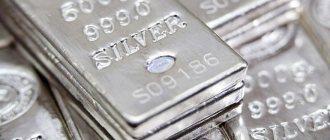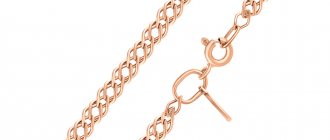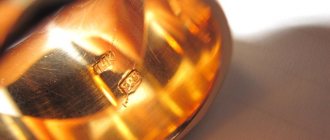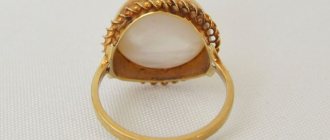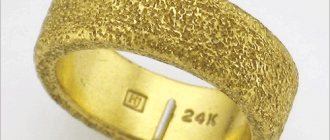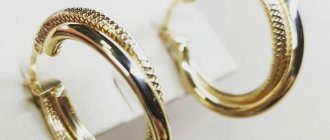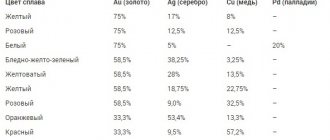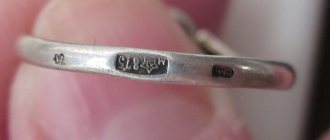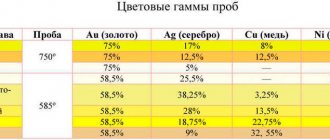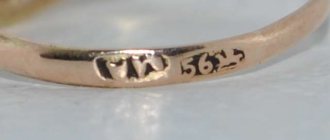What is silver hallmark?
Silver is one of the noble metals that are not susceptible to oxidation or corrosion. In the periodic table D.I. Mendeleev's silver is designated Ag (from the Latin Argentum) and is listed at number 47. It is a silver-white metal characterized by high ductility.
Pure silver is quite soft, so it is not suitable for the production of dishes, jewelry and other products. To prevent silver from bending and breaking, other metals are added to it. Since the amount of such impurities has varied since the beginning of silver production, it became necessary to introduce the concept of “fineness.”
The sample shows how much silver is contained in a particular alloy. For example, 800 fineness means that 1000 g of alloy contains 800 g of silver and 200 g of impurities. In the future, this information is used to use specific silver alloy samples for the production of certain products. For example, 800 hallmark is more suitable for making cutlery, while 925 hallmark is used for jewelry (more on this below). Hallmark is also a name stamped on a silver item.
Brand A.M. Postnikov on a silver item.
Story
Silver spoons appeared in antiquity - in Ancient Greece and Rome. In the Middle Ages, silverware was mainly used by the nobility and the king's court. They became more widespread during the Renaissance. Then an interesting custom arose to give so-called apostolic spoons for christenings. The handles of the spoons were decorated with images of saints, Jesus and the Virgin Mary.
Silver teaspoons
Richer godparents gave a couple of spoons, and eminent and noble birthday people received a full table set for 12 items.
The child was usually given a spoon with the name of the apostle after whom he was named.
Not everyone could afford such a gift. Therefore, the proverb appeared: “He was born with a silver spoon in his mouth.”
The custom of decorating cutlery spread in the Baroque era, when spoons began to be decorated with complex patterns, landscapes and other images began to be applied to them.
In Rus', silver spoons appeared at the end of the first millennium. In 998, Prince Vladimir's squad received spoons as a gift for converting to the Christian faith and abandoning paganism.
In Russia, a spoon was a good gift. It was given not only as a gift, but also in honor of the child’s admission to the gymnasium, and to newlyweds for a wedding. A wealthy family stocked up their daughter's cutlery as a dowry. It was usually passed down from generation to generation.
Types of silver samples
Copper is usually used as the main element of a silver alloy. The copper content in the alloy makes it more durable, but at the same time the product becomes yellow and darkens over time when exposed to air. The more copper it contains, the more intense the darkening of silver occurs.
The table below shows the most common metric hallmarks of silver. This system operates in Russia and the CIS countries, in Germany, France and those states that have signed the Convention on the Control and Hallmarking of Precious Metal Products.
| Try | Silver, g | Copper, g | Manufactured products |
| 800 | 800 | 200 | Cutlery |
| 830 | 830 | 170 | Cutlery, inexpensive jewelry |
| 875 | 875 | 125 | Interior decorations, dishes, jewelry |
| 925 | 925 | 75 | Jewelry, interior decorations, expensive cutlery, coins, memorial signs |
| 960 | 960 | 40 | Jewelry and highly artistic decor |
Characteristics of silver samples
800th sample. This is a high-strength alloy characterized by good casting properties. However, silver of this standard is subject to rapid oxidation (darkens in air) and, due to the high copper content, has a yellow tint, which is why it is used for making cutlery, but not for jewelry. It is also called yellow silver.
830th sample. The presence of an extra 30 grams of silver in every kilogram of the alloy makes it more suitable for making jewelry. Due to the low silver content, jewelry of this standard is cheaper, but its properties leave much to be desired. They also oxidize quickly.
875th sample. This grade of silver is great for cutlery, but for jewelry, the silver alloy still contains too much copper. Although, in comparison with the 800th standard, such silver does not have a characteristic yellow tint, it loses its beauty over time and is difficult to machine.
925th sample. Silver of this standard, also called standard or sterling, is most common in jewelry production. This is due to the fact that a large amount of silver in the alloy makes it flexible and beautiful enough to create products of the most bizarre shapes. At the same time, the presence of 75 grams of copper does not give the silver a yellow tint and at the same time makes the alloy more durable than pure silver. 925 silver may be confused with gold because sterling silver jewelry is often plated with gold. To avoid confusion, it is enough to know that gold does not have such a standard.
960th sample. Silver of this standard is considered high quality and is used for jewelry. Since it is very soft, it makes jewelry and decorative items that require the finest artistic work. The price to pay for such an amount of silver in the alloy is that the finished products are easily scratched and damaged. To make the product more durable, it is enameled.
999th sample
. Because pure silver is too soft and subject to deformation during use, it is not used to make jewelry. In everyday life, silver of the highest standard is used in the production of solders, as well as for the manufacture of parts for various devices. It can also be found in jars in the form of silver bars. In some countries, such as Japan, pure silver is used in magical rituals.
Pure 999 silver bar.
There are other standards in the metric measurement system (see table below). For example, in Soviet times, sample 916 with a characteristic stamp shape in the form of a barrel was common. It was used to make jewelry, dishes, candlesticks and items for various rituals. Today this test is not used.
Cognac set made of 916 sterling silver. Enamel, gilding. Russia. 1960s
916 hallmark in the form of a barrel.
A low-grade silver alloy, in which less than 80% silver is present (fineness below 800), is called technical. It is typically used in industry, such as circuit board manufacturing.
Marking of silver jewelry in different countries
As you know, the sampling system was adopted in the territory of the former USSR as GOST and is not subject to challenge when the question concerns authenticity. In Europe and the USA, the standard is to measure the purity of a jewelry alloy in carats, but the situation is even more interesting with antique items. In pre-revolutionary Russia there was an old sample standard - the spool, which according to modern calculations is equal to 4.26 grams with an error of foreign impurities.
By combining three different systems, we get a universal comparison table:
| Silver standard (Russia) | Spool (antique measure) | Karat (Europe and USA) |
| 800 | 77 | 19 |
| 830 | 80 | 20 |
| 875 | 84 | 21 |
| 925 | 88 | 22 |
| 960 | 92 | 23 |
Interestingly, the Russian aristocracy was not very fond of silver items above 84 spools. Firstly, smelting pure metal was very expensive, and they tried to send it strictly for jewelry miniatures. Secondly, the analogue of the current 875 standard turned out to be less demanding in terms of hygiene, so vases, plates and other utensils were often made from it.
You can also distinguish antique silver from a fake using a hallmark. Instead of the logo of the Assay Commission, pre-revolutionary items were stamped with the coat of arms of the province in which the workshop was located or, less commonly, the initials of the jeweler himself with a facsimile.
Other sample systems
The product catalog on our website contains antique silver items of 84 standard, which can simply be puzzling. Is it really possible to create products with only 84 grams of silver per kilogram of alloy? In fact, this sample is specified in a different measurement system. Until 1927, in Russia there was a so-called spool sampling system, measured in spools. If we convert it to the metric system, then the 84th hallmark will correspond to the 875th hallmark of silver (see table below).
Ladle made of 84-carat silver. Gilding inside. Russian empire. 1881
Hallmark of 84th silver standard.
Silver samples in different measurement systems.
Assay systems used around the world
Our country currently uses the metric assay system. It shows the number of parts per thousand of pure metal. If you divide this value by 10, you can get its percentage. For example, 585 gold will contain 58.5%, and 925 silver will contain 92.5%.
The karate system is used in many countries around the world. Most European countries and America use it. Pure metal has a purity of 24 carats. If there is only half of it in the alloy, then such a product will have a purity of 12 carats. You can calculate the metric sample from a carat sample using the formula k * m / 1000, where k is the sample in carats, m is the metric sample.
Density of silver depending on the sample
In Tsarist Russia, a spool test was used. Zolotnik was a weight measure that was equal to 1/96 of a Russian pound, approximately four grams.
Varieties of silver
Even in ancient times, it was noted that not only its quality, but also its appearance depended on the composition of the silver alloy. This is how various types of alloys appeared, as well as different methods of processing finished products, which are very popular in the production of silver products.
Blackened silver
In Ancient Rus', even before the advent of our era, they discovered a method of blackening silver, when products were covered with beautiful black patterns. By mixing silver, copper, lead and sulfur in certain proportions, the so-called niello was obtained. After engraving the silver item, it was heated until the niello was completely dissolved and turned black. The result was an interesting combination of dark and light shades.
Liquor set made of blackened 875 silver. USSR, Northern Chern. 1966
At first, blackened silver was used mainly to create amulets and elixirs, but with the heyday of blackening in the 17th century, engravings, cigarette cases, dishes and other products began to appear, which were considered very fashionable to have. A special feature of blackened silver is its strength. Products made from it do not need cleaning.
Oxidized silver
The combination of silver with sulfur also leads to darkening of the noble metal, but this combination has its own characteristics. While blackened silver is a strong compound, the same cannot be said about oxidized silver. The darkening effect here is created using a special film, which is easily damaged during the cleaning process. Therefore, you need to carefully inspect the product when purchasing, so as not to buy oxidized silver instead of blackened silver.
It is worth noting that both methods of processing silver have their own jewelry value. In particular, oxidation allows you to play with shades of black and even purple, giving the product not only the effect of antiquity and nobility, but also making it more colorful. After polishing, the convex parts of the oxidized silver product become shiny, and the concave parts become dark.
Ring made of oxidized silver. Convex and concave areas have different shades.
Typically, oxidized silver is used to create small-sized jewelry. These can be handmade earrings, chains or bracelets, as well as products in need of restoration. Since blackened and oxidized silver are practically the same in price, the buyer decides for himself which material to choose.
Matte silver
Matte silver has a noble appearance and is resistant to tarnishing. The natural shine of silver is removed using special equipment such as a sandblaster, as well as by etching in certain solutions.
Silver egg-purse. Enamel on filigree. Russian empire. 1908-1917
Gilt silver
Spraying silver with a thin layer of gold gives the silver item not only a luxurious appearance, but also increases its chemical resistance. Gold-plated silver cutlery is suitable for salty and acidic environments where regular silver would react chemically.
Gilded milk jug. 950 standard silver. France. End of the 19th century
There are other varieties of silver obtained using different techniques and substances.
Gold-plated and technical silver - what's the difference?
Gilding is a compromise and budget option for using expensive metal in jewelry. It is applied in a thin layer on a silver base, as was done in the first half of the 19th century, but today there is an international quality classification:
- Gold Plated (GP) is the same electroplating method that many people remember from their school physics course. Quite simple in mass production, but has a number of disadvantages. The coating layer rarely exceeds 1-2 microns, which makes the metal vulnerable to any reactions on the body. Detected by a simple temperature test.
- Gold Filled (GF) – so-called high temperature rolling. The precious layer is much thicker - around 10-12 microns. The product is no longer afraid of long-term contact with human skin and subsequent oxidation of the surface, but everything is also easily determined by special equipment or a chemical reaction.
- Gold Soldered (GS) is the most expensive option, where the silver substrate is practically indistinguishable even under the influence of laboratory reagents. The thickness of the gold plating is up to 17 microns and higher, which puts the jewelry on a par with elite ones.
Gilding comes in three silver standards - 875, 916 and 925. Until recently, according to Russian laws, such products did not need to be stamped at all, but now the situation has changed. If the mass fraction of pure metal is more than 80%, manufacturers try to indicate the quality category with at least a two-letter designation - GF, GS or GP.
Technical silver is a separate category that has nothing to do with jewelry, despite the fact that exact sciences require the purest 999 standard with a minimum error of impurities. It is used in such serious industries as:
- Electronics;
- Medicine and prosthetics;
- Aviation and space construction;
- Energy;
- Radio engineering, etc.
You can buy industrial silver only in specialized raw materials stores; Russian laws do not impose restrictions, although in a number of countries retail sales are completely prohibited. For jewelers, such metal is not of particular value - much more effort and resources are spent on refining it than purchasing ready-made ingots.
Authenticity of silver products
There are quite a lot of fake silver items on the market, which may have “branded” hallmarks (hallmarks). The great demand for such products is due to the fact that many buyers have no idea what a sample should actually look like. They already consider the presence of such a sample to be sufficient reason to believe in the authenticity of the product. At the same time, for counterfeiters, stamping is not a particularly big problem. But a professional will always be able to distinguish a fake brand from a real one.
Fake samples
To determine the authenticity of a particular mark, you need to at least know the specifics of the forgery process itself. Fake products are often made of soft metals, so the marks have softer contours.
When determining the authenticity of a hallmark on an antique silver product, it is necessary to take into account the specifics of production. Fraudsters often do not take into account that this or that sample was used only in specific years of production, and was also placed in certain places of branding. For example, in Russia, silver was stamped with an image of a woman’s head in a kokoshnik, a digital hallmark and the letter of the state inspectorate. At first, the woman's face was turned to the left, but since 1908 it has been turned in the opposite direction. Also, in different years, product marks were placed in different places.
Sample with the image of a woman in a kokoshnik (turned to the left). The product was produced in the period 1899-1908.
Sample with the image of a woman in a kokoshnik (turned to the right). The product was produced at the end of the 19th century. – early 20th century
In addition, different countries have their own standards, which also need to be taken into account when working with the sample. For example, English silver hallmarks have their own characteristics compared to French or Russian hallmarks.
One of the common techniques used by counterfeit manufacturers is to transfer the original mark from one item to another. In particular, it can be taken from a spoon and soldered to an expensive antique silver item. Professionals skillfully hide the soldering area under the engraving. And yet, upon closer examination, traces of soldering can be detected, especially if you breathe on this place.
Upon careful examination of the product under a magnifying glass, you can also notice a difference in the wear of the stamp and the product itself, which also indicates a fake.
At the same time, high-quality fakes can only be identified by professionals using special equipment. It allows you to detect both an alloy composition that is uncharacteristic for a particular production period and a lack of protection. Information about the degrees of protection is contained in the technical documentation for the mark and is under state protection.
How to determine the authenticity of silver
The authenticity of a silver item should be determined by an expert, especially if we are talking about antiques. However, at home you can always conduct simple experiments that will allow you to suspect a fake.
If a silver product is magnetic, then this is a fake, since silver never magnetizes. At the same time, the absence of interaction with a magnet does not prove its authenticity, since some metals and alloys are also not magnetic.
The presence of another metal under the silver can also be a clear sign of a fake. It is enough to make a scratch with a sharp object to find out.
If the product does not become hot when placed in hot water for a few seconds, it means it contains metals with low thermal conductivity. Silver heats up instantly, as it has high thermal conductivity.
If a silver item gets your hands dirty, it contains a lot of zinc. In such cases, cunning sellers like to come up with various excuses, for example, that the person whose hands were dirty with a silver amulet is damaged.
It is worth taking a closer look at the quality of the product itself. For example, if we are talking about a silver chain, then every detail of a branded item is carefully worked out. At the same time, a fake usually contains small elements of low quality or enlarged to simplify production. On counterfeit products, the locks may not close properly, and individual elements may have uneven edges or irregular shapes. It is also possible for the links to break, their length and shape to vary.
The peculiarity of home methods for determining the authenticity of a silver product is that they cannot be called reliable. With their help, you can only suspect a fake, but you cannot prove the originality of the product, so it is always better to seek help from experts.
Unification of marks in France
The royal tax system collapsed after the revolution, and for several years no one controlled the jewelers. New rules were approved by the government of Napoleon Bonaparte (Napulione Buonaparte) in 1797. The right to test metal for samples has moved from the authority of workshops to the state level. The purity of the silver was certified by a poincon de titre stamp, with the image of a rooster, supplemented by a letter designation of the date and sample number. In 1819, the design of a rooster was replaced by a male profile wearing a Phrygian cap. Payment of the fee was certified by the poincon de garantie stamp with a drawing of a head and the number of the tax district.
During this period, the demand for silver fell sharply, and craftsmen stopped paying attention to quality. Jewelers often used simplified finishing methods - first making individual elements and then putting them together. This technology did not affect the external beauty of the item, but significantly reduced its cost. At the same time, the country was flooded with fake stamps, which allowed manufacturers to save on taxes.
After the restoration of the monarchy, the appearance of the guarantee markings changed - royal symbols appeared on the stamps, and departments received different numbers. In 1838, the first unified mark certifying the sample appeared - the head of Minerva. Additionally, a silver standard figure was added. One denoted 950 samples, two - 800 samples. Export products were stamped with the head of Mercury. In 1840, the image of Hermes appeared on state guarantee stamps, and a drawing of a crab or a boar's head appeared on small markings. The hare's head signified exemption from duty.
From that moment on, the French marks acquired a finished look and were no longer changed. Silver produced after the introduction of the unified system is easy to identify. Determining the production date may cause difficulties, since no marks were provided for this. In this case, you should focus on the design and style of the item, as well as workshop marks.
Which spoons are valued?
First of all, sets are valued, not isolated copies. Of course, a spoon with a master's name, decorated with a monogram, also has a high cost. But not only millionaires can afford to buy them. The cost of devices is in the thousands, not millions of dollars.
In 1912, at a Christie's auction, a pair of Faberge spoons went for $8,000. The spoon, made by Fedor Ruckert, sold for $12,500.
Silverware from German jewelers is prized throughout the world. The Robbe&Berking company supplies instruments to the palaces of oil sheikhs and to the court of the Queen of Great Britain. The companies Robert Freund, Franz Schnell Halle, Herbert Zeitner became famous.
English tableware from William Suckling, Ridley&Hayes and many other craftsmen is prized. Jewelers from Denmark also became famous for their silver products.
Among the masters from Russia, the firms of the Grachev brothers, Sazikov, Ovchinnikov, Khlebnikov and, of course, Faberge are famous.
Many of them were suppliers to the imperial court. This was honorable and prestigious; usually the products of these companies were branded with a special sign.
How much do the devices of these masters cost in Europe? The prices cannot be called exorbitant. For example, a gilded spoon, the handle of which is decorated with an image of the Virgin and Child, by the famous master A. Michelsen (Denmark) is valued at $230. It was made in 1916. Prices for this master's devices range from $50 to $600 per unit.
Antique silver spoons of the 19th-18th centuries, made by famous masters, may cost a little more. For example, a set of silverware (six forks and spoons) - manufactured in 1855 - by jeweler Hippolyte Thomas in one of the online antique stores is offered for one and a half thousand dollars. The devices are decorated with the owner’s monogram and look great; their weight is more than a kilogram.

